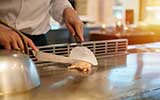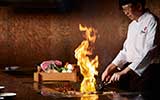Hibachi Grill | Teppanyaki Table | How to Make A Hibachi Dinner?
In Japan, hibachi is a charcoal brazier used for heating rooms and cooking. In the U.S., hibachi can be a small hibachi grill popular with apartment dwellers and people with small yards, but the term is also used to refer to restaurant teppanyaki tables — correctly called teppanyaki — with a hot top in the middle , The chef was there to cook for several parties. Cooking hibachi style does not require special equipment because the basic principle is to cook small amounts of food quickly at high temperatures.
Cut beef, pork, or chicken into thin slices and bring to room temperature before cooking. Refrigerate the seafood until you are ready to cook, because fish and shellfish tend to produce bacteria faster.
Cut the vegetables into thin strips, called Julian strips, all of the same size and shape. Typical vegetables include onions, mushrooms, carrots, cabbage and bean sprouts. Tofu cubes are also commonly used.
Keep all the ingredients within reach, including one serving of rice or noodles per person.
Coat the cooking surface with olive or canola oil.
Heat the oiled cooking noodles to a high temperature. This can be a large frying pan, wok or pan.
Cook the vegetables first, sprinkle with sesame oil and Asian seasonings while cooking. Seasonings can include garlic, ginger, sesame and seaweed powder and pre-mixed stir-fry seasonings. If your heat source is large enough, push the vegetables aside. If not, you need a second pan.
When your vegetables have 1 to 2 minutes to cook, cook your protein. Season the protein and push it aside, or put it on a plate.
Add a little sesame oil to the hot noodles, add cooked rice or noodles. Season with spices and soy sauce and heat. If you are making fried rice, you can add peas and corn during the fried rice process. Scallions and bean sprouts go well with the noodles. If you cook rice and noodles on the hibachi grill, you can use the stove or microwave to heat them.
Put protein, vegetables, rice or noodles on a plate, and provide soy sauce, chopsticks or forks to those who like Western-style tableware.





